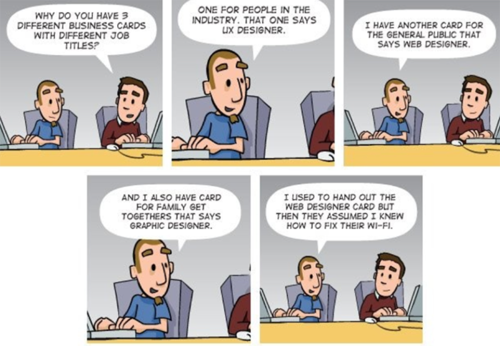The UX of Explaining UX
Published on December 21, 2015 by Hannah Dym
With the holidays almost here, the season is upon us for spending time with family and friends. As we gather with grandparents, cousins, and long-lost friends who we rarely see, an inevitable question will surely arise: “So, what are you up to these days?” As a graduate student studying user experience (UX) design in the Human Factors in Information Design program at Bentley University, I often find myself struggling for words when faced with the question, “What is UX?” Despite repeated attempts to explain what it is that I do, I still often fail to articulate it in a meaningful way.
Inevitably, when I answer this question, I am met with blank stares or something along the lines of, “Oh, so you mean like Marketing?” After trying to put together coherent words that can clarify my explanation, I usually end up stumbling upon something to the effect of: “I make websites and software easier to use.” On a few occasions, this has been followed by something completely irrelevant, like: “Oh great… do you know why this app isn’t working?” As somebody who is very excited to be working in the multi-dimensional domain of UX, these types of conversations can be disheartening. So, in an effort to advocate for the field, I’ll often try to underscore all the great things being done in UX and all the different skills I will be able to implement in this profession as I make products and services easier to use.

After repeated struggles (and occasional wins) on this front, it occurred to me that perhaps there are strategies I can employ to help ease the comprehension gap when it comes to explaining UX. So, I turned to blogs and articles, and found comfort in learning that this is, indeed, a conundrum that others in the industry face. After reading about the collective strategies for explaining UX, I came to realize that there is a lot of overlap between the art of explaining UX, and the field itself. In other words, by abiding by the key tenants of user-centered design and implementing some UX-related strategies, I just might be better equipped to explain UX to others.
The following 6 tips represent what I have taken away from my research on this topic, and will offer readers strategies to use when explaining what exactly UX is all about. Incidentally, they all relate to important principles of user experience design:
- Know your audience
- Understand your audience's mental model
- Keep it simple
- Get the language right
- Only reveal more content when needed
- Have empathy
#1: KNOW YOUR AUDIENCE
If you have ever created or used personas, you know they can be a helpful tool for keeping the motivations, needs, and frustrations of key users front of mind. This way, products can be optimized for whoever they are being designed for.
- When trying to explain what UX is all about, it is important to keep in mind the “persona” of who you are speaking with. For instance, if your 90-year old grandma is curious about your current job, the answer you give will likely be different than what you might offer to the VP of Finance at your company.
- Frame your explanation of UX in a way that will resonate with the person you are speaking with, and be willing to customize your approach. Below are some examples of how an explanation of UX can be adapted to different audiences:
- To your 90-year old grandma, you might say: “I work to make computers easier to use for everyone.”
- To a VP of Finance, you could say: “I work to make products and services easier to understand, so that customers can save time and frustration. UX work, especially if done early in the development process when changes cost less to make, will often greatly improve the experience of using the product. This can ultimately result in a greater ROI.”
- To a teacher, you might explain: “I work to make products easier to learn how to use. Just as students have different ways of learning, users have different strategies for approaching new technology. By researching how target users think, UX professionals can create products that have a smaller learning curve and quicker utility.”
#2: UNDERSTAND YOUR AUDIENCE’S MENTAL MODEL
In the UX community, mental models are a hot topic of conversation. If a target user’s conceptualization of how something works is not consistent with how the product actually works, usability problems will inevitably arise. Therefore, before even attempting to design a product, UX professionals need to research and understand how their target users think.
- As you explain UX, try to consider the lens through which the person you are speaking with might best understand the concept. Are they an engineer? Then frame the conversation in terms of how UX professionals inform the work that software developers do. Is the person a dentist? Then explain UX in terms of how it can contribute to improving medical devices and electronic health records.
- If you can anticipate what your audience already knows about UX or related disciplines, then you can frame the conversation in a way that will maximize the likelihood that things will click for them.
#3: KEEP IT SIMPLE
For many products and services, simpler is better. Streamlining functionality into as few steps as possible saves users time and most likely, frustration.
- If you have a clear and simple speech about UX at your disposal, it will be easier to use in conversation. This is similar to the classic “elevator pitch” idea, namely that if you only had a few minutes to convey your value proposition as a UX professional, what would you say? How could you boil down your mission statement into an effective blurb that will resonate with many people?
- While the elevator pitch concept is often tied to business or networking situations, it will also enable you to more confidently explain UX to family and friends without stumbling through a long speech.
#4: GET THE LANGUAGE RIGHT
In the realm of UX, expert users working with their software tool of choice don’t want to see basic content that undermines their intelligence and domain expertise. At the same time, novice users will struggle to understand how to use products that have a steep learning curve or are built on concepts that are difficult to understand. Therefore, the language and concepts used in products should be consistent with the anticipated level of expertise of users.
- Similar to the idea of simplicity explained above, aim to minimize your use of expert terminology related to UX when speaking with those who are not familiar with the field. This can be harder than you might think, especially considering how often UX professionals throw around phrases like “cognitive load” and “contextual help”. Instead, try to keep this expert jargon on the back burner, no matter how natural it may seem. Of course, if you find yourself speaking with a UX pro, then there’s no need to keep “human factors” in your back pocket.
- Keeping your audience engaged starts by making them feel included in the conversation, and nothing will cause their eyes to glaze over more than an academic-sounding term. Again, this comes down to who you are speaking with, which is another reason why understanding your audience is of the utmost importance.
#5: ONLY REVEAL MORE CONTENT WHEN NEEDED
When designing interfaces, one strategy is to reveal new content or available actions based on previous steps the user took. This technique, called progressive disclosure, can limit the amount of information that is on the screen at once and can better cater the material to the individual.
- It may be easy to prepare a conversation about UX if you know in advance who you will be speaking with, but what if you don’t know? Perhaps you are going to a networking event, and may need to chat with people who have a variety of perspectives. In this case, it may be helpful to implement progressive disclosure and shape your discussion of UX based on the real-time feedback you receive from your audience. For instance, you may want to start simple with something like “UX professionals aim to make products and services easier and more enjoyable to use.” If the person you are speaking with seems engaged in the conversation (or better yet they already know what UX is!), then you can progressively add more information and details about the work that you do, such as “Sure, I’ve done usability testing on mobile devices before.”
- There’s no need to push a conversation about UX further than it has to go. If you can’t crack the surface and your audience appears uninterested or confused, then stick with the novice terminology mentioned above and try not to get too wrapped up in your love of talking about UX.
#6: HAVE EMPATHY
UX professionals know how important it is to have empathy for users, and to make lives easier through better designed products. At the same time, it can sometimes feel like an uphill battle trying to explain and advocate for the rapidly evolving field of UX. While these conversations may be difficult, it is important to face them with empathy for your audience and an awareness that many people are not familiar with UX-related concepts. The less likely UX advocates are to get defensive about a lack of comprehension from others, the more likely they will be able to spread the word in an effective way. In the end, whether you find yourself talking to your mom or your manager, the benefits of having empathy cannot be understated.
So during your next encounter, be it under the Christmas tree or over a drink at your next high school reunion, you’re now more equipped to explain UX, no matter who you run into.
RESOURCES
To see what others are saying on this topic, check out the following sources that I referenced:
- https://uxmag.com/articles/explaining-ux-design-to-high-schoolers
- https://blog.generalassemb.ly/explain-job-parents/
- https://www.quora.com/How-do-IxD-UI-UX-designers-introduce-themselves-at...
- https://www.quora.com/How-do-you-explain-user-experience-design-to-a-layman

HANNAH DYM
Hannah Dym is a Research Associate at the User Experience Center at Bentley University. She previously worked as a Marketing Specialist at the Massachusetts Institute of Technology Federal Credit Union, and maintains several freelance web and print design projects for clients in the insurance, financial services, and health care industries. Hannah received a Bachelor of Science degree in Electronic Media, Arts and Communication from Rensselaer Polytechnic Institute. She also holds a Certificate in Web Design and Development from the University of Massachusetts Lowell, and is currently pursuing her Master of Science degree in Human Factors in Information Design at Bentley University.


